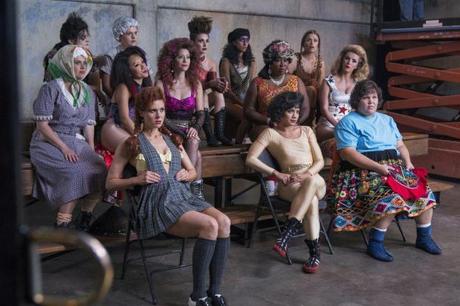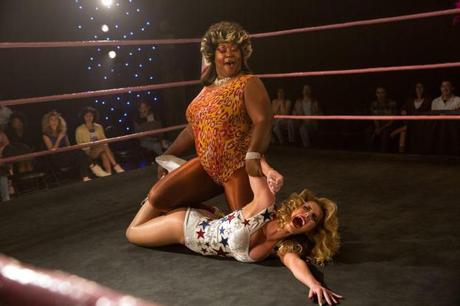Over a glorious two-day period last year, I devoured GLOW's 10-episode first season and came away thoroughly entertained. Show creators Liz Flahive and Carly Mensch had taken the real life story of an all-ladies wrestling TV show in the 80s and turned it into a thoroughly lovable League of their Own riff. Similar to that Geena Davis classic, GLOW 's story was less about a sport and more about women finding their own agency. To that end, the obvious central relationship was Ruth (Alison Brie) and Debbie's (Betty Gilpin) fractured friendship, the pair torn apart by infidelity and professional rivalry. This was both a blessing and a curse, though. Brie and Gilpin made for fantastic foils, but they also pulled focus from just about everyone else in the cast other than Marc Marcon's obvious Tom Hanks stand-in.
Season 2 fixes that. In fact, season 2 fixes just about all of GLOW 's weaknesses:

The full ensemble cast - there are nearly 15 different women wrestlers on the show, after all - is finally utilized. The simple female empowerment story (yay, we learned how to wrestle and managed to make a pilot!) gains many new dimensions (umm, staying on the air is going to be so much harder than we realized since the male bosses at the network are total dicks). The 1985 setting is finally leaned on for more than just sartorial and soundtrack glory, providing a surprising turn into a rather restrained AIDS commentary as well as a depressing, but accurate depiction of living through sexual assault decades before #MeToo. An episode pitched to us as if it was just GLOW's show-within-a-show finally gives us a full sense of the 80s kitsch appeal of the original GLOW. Plus, the experience of working on the show and playing one of its many offensive stereotypes (like a black woman playing someone called "Welfare Queen") is finally mined for real drama instead of passing comedy.
By the end, when all of the storylines merge in a joyous finale it makes for a richer and more rewarding season, one that took bigger chances, dared to pull back on Brie and Gilpin's screen time, and prospered as a result. Netflix's hopefully inevitable season 3 renewal can't come fast enough. Maybe next time they'll give them more than 10 episodes because if there's one consistent flaw across the first two seasons it's simply that Flahive and Mensch's storytelling ambitions deserve/need either longer episodes or simply more total episodes to truly flourish.
After finishing the second season, I circled back around to the documentary about the real GLOW, just to jog my memory as to how different Flahive and Mensch's GLOW is from the actual Gorgeous Ladies of Wrestling which filmed out of a Vegas hotel and aired on TV for four seasons in the late 80s. Not surprisingly, other than a mid-season twist involving one of the characters getting seriously injured in the ring very little of what Flahive and Mensch do with these new GLOW episodes is based in anything covered in the documentary. In fact, this rewatch made it all the more clear just how much Flahive and Mensch - and their almost entirely female writing staff and roster of directors - are using GLOW as a vehicle to talk about today.
So, season 2 touches on the plight of female directors, the gender pay gap, #MeToo arguments in a pre-social media age, sexual awakening (we get our first openly gay characters), being a working mother, and the general challenges of being female creators working within a male-dominated industry. This could easily translate into strident preachiness, yet it works in seamlessly because GLOW is ultimately a character-based series, not issue-based. Since the first season did all of the heavy lifting in establishing the characters and pitching them to us as the underdogs the second season is freed to take them into some more complicated areas.
Thus, the best episode of the season, "Mother of All Matches," is arguably the one that's most character-based. SPOILER WARNING As VOX summarized, "The build-up to a big title match between Debbie and opponent Tammé Dawson ( Kia Stevens) becomes a focus on how both women, single moms raising sons (Debbie with her ex-husband's help, Tammé seemingly without help), navigate trying to build a better world for their boys while also chasing their own dreams."

In wrestling terms, Debbie's southern-accented, white Americana "Liberty Belle" character is the obvious babyface (good guy) and Tammé's "Welfare Queen" the heel (bad guy). However, away from the ring, Debbie is completely flailing through a rough divorce, to the point of getting passed-out day drunk on wine and forgetting her son at daycare. Tammé, on the other hand, spends her day prior to the match driving to Stanford to visit her son and beam with motherly pride.
Thus, when the two come together for their match the crowd sees one thing while we know the truth of the matter is quite different. They could not be any further away from the characters they play, yet the act finally catches up to Tammé since her son insists on coming to watch from the crowd. The discomfort and disappointment on his face from watching his mother play a minstrel character devastate her, forcing her to run out of the ring in shame.
After the show, he reassures her that while he was indeed offended by her character he was also impressed to see her wrestling. He got a certain kick out of watching her throw a white girl around the ring. They embrace and go out for dinner, after which he drives her home as she sleeps. At that same moment, Debbie, after a tongue-lashing from her ex, falls asleep next to her son's crib.
As Vox concluded, "This is where GLOW excels in season two, in its ideas of womanhood as a kind of performance given to the public, the costume later taken off at home, alone, when nobody but those who love you best can see it."
It's not the kind of episode I think they could have pulled off last year. However, with a firmly established set of characters and clear better sense of what kind of story they're telling the women of GLOW have turned the corner into becoming one of Netflix's best.
BOTTOM LINEGLOW's evolution into becoming the new Orange is the New Black is complete. What began as an enjoyably flawed story about two white girls has turned into a richly rewarding ensemble story about a diverse group of women finding sisterhood together while fighting against the constraints put on them by men. Plus, it's still so much fun watching them work out their drama through kitschy 80s wrestling.
RANDOM PARTING THOUGHTS
- Favorite line: Debbie: I hope your date likes the "if the devil managed a sizzler" look.
- Hal Freeman is briefly referenced. Here's a link to a Wikipedia page explaining why he was so important.
- One misstep: Ruth is forced into a love triangle that doesn't completely work.
- For around half the season, Sam is back to being a small-minded antagonist. So, Maron's lovable-misanthrope act isn't fully unleashed until the second half of the season, which ends up getting a lot of good material out of Sam growing into his new role as father to a teenage runaway.
- Debbie and Ruth have a cathartic shouting match for the ages this season.
- Breakout ensemble character: Jackie Tohn's Melanie Rosen, the obvious Madonna party girl who grows to love being part of the group, in keeping with the League of Their Own comparison. It's not even that Melanie gets significantly more to do this season; it's more Tohn just completely owns every single one-liner they give her.
- Ensemble characters I still want to see more of: Sheila ("She Wolf"), Carmen ("Machu Picchu") and Arthie ("Beirut the Mad Bomber")

